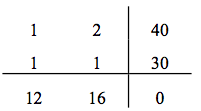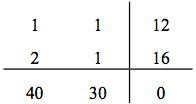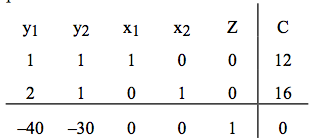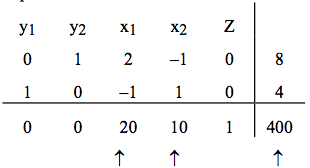| << Chapter < Page | Chapter >> Page > |
In this section, we will solve the standard linear programming minimization problems using the simplex method. Once again, we remind the reader that in the standard minimization problems all constraints are of the form . The procedure to solve these problems was developed by Dr. John Von Neuman. It involves solving an associated problem called the dual problem . To every minimization problem there corresponds a dual problem. The solution of the dual problem is used to find the solution of the original problem. The dual problem is really a maximization problem which we already learned to solve in the [link] . We will first solve the dual problem by the simplex method and then, from the final simplex tableau, we will extract the solution to the original minimization problem.
Before we go any further, however, we first learn to convert a minimization problem into its corresponding maximization problem called its dual.
Convert the following minimization problem into its dual.
Minimize
Subject to:
To achieve our goal, we first express our problem as the following matrix.

Observe that this table looks like an initial simplex tableau without the slack variables. Next, we write a matrix whose columns are the rows of this matrix, and the rows are the columns. Such a matrix is called a transpose of the original matrix. We get

The following maximization problem associated with the above matrix is called its dual.
Maximize
Subject to:
We have chosen the variables as y's, instead of x's, to distinguish the two problems.
Solve graphically both the minimization problem and its dual, the maximization problem.
Our minimization problem is as follows.
Minimize
Subject to:
We now graph the inequalities.

We have plotted the graph, shaded the feasibility region, and labeled the corner points. The corner point (20, 10) gives the lowest value for the objective function and that value is 400.
Now its dual.
Maximize
Subject to:
We graph the inequalities.

Again, we have plotted the graph, shaded the feasibility region, and labeled the corner points. The corner point (4, 8) gives the highest value for the objective function, with a value of 400.
The reader may recognize that this problem is the same as [link] , in [link] . This is also the same problem as [link] in [link] , where we solved it by the simplex method.
We observe that the minimum value of the minimization problem is the same as the maximum value of the maximization problem; they are both 400. This is not a coincident. We state the duality principle.
Our next goal is to extract the solution for our minimization problem from the corresponding dual. To do this, we solve the dual by the simplex method.
Find the solution to the minimization problem in [link] by solving its dual using the simplex method. We rewrite our problem.
Minimize
Subject to:
The dual is as follows:
Maximize
Subject to:
Once again, we remind the reader that we solved the above problem by the simplex method in [link] , in [link] . Therefore, we will only show the initial and final simplex tableau.
The initial simplex tableau is

Observe an important change. Here our main variables are and and the slack variables are and .
The final simplex tableau reads as follows:

A closer look at this table reveals that the and values along with the minimum value for the minimization problem can be obtained from the last row of the final tableau. We have highlighted these values by the arrows.
We restate the solution as follows:
The minimization problem has a minimum value of 400 at the corner point (20, 10).
We now summarize our discussion so far.

Notification Switch
Would you like to follow the 'Applied finite mathematics' conversation and receive update notifications?